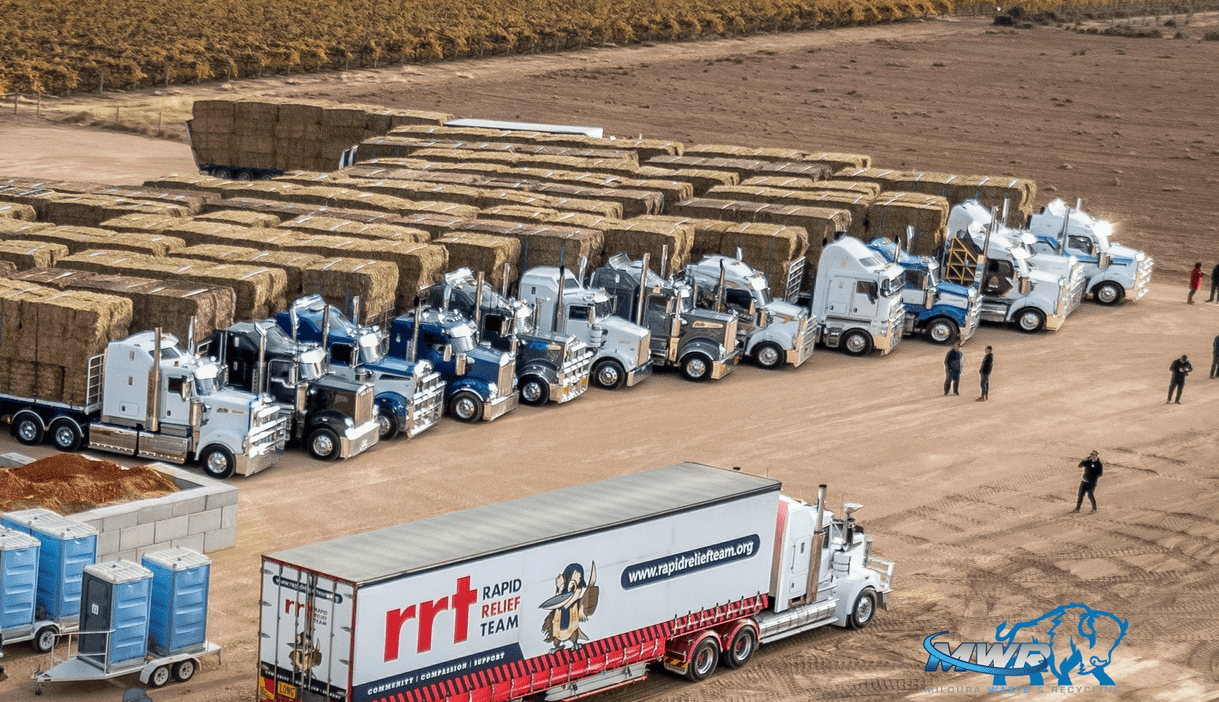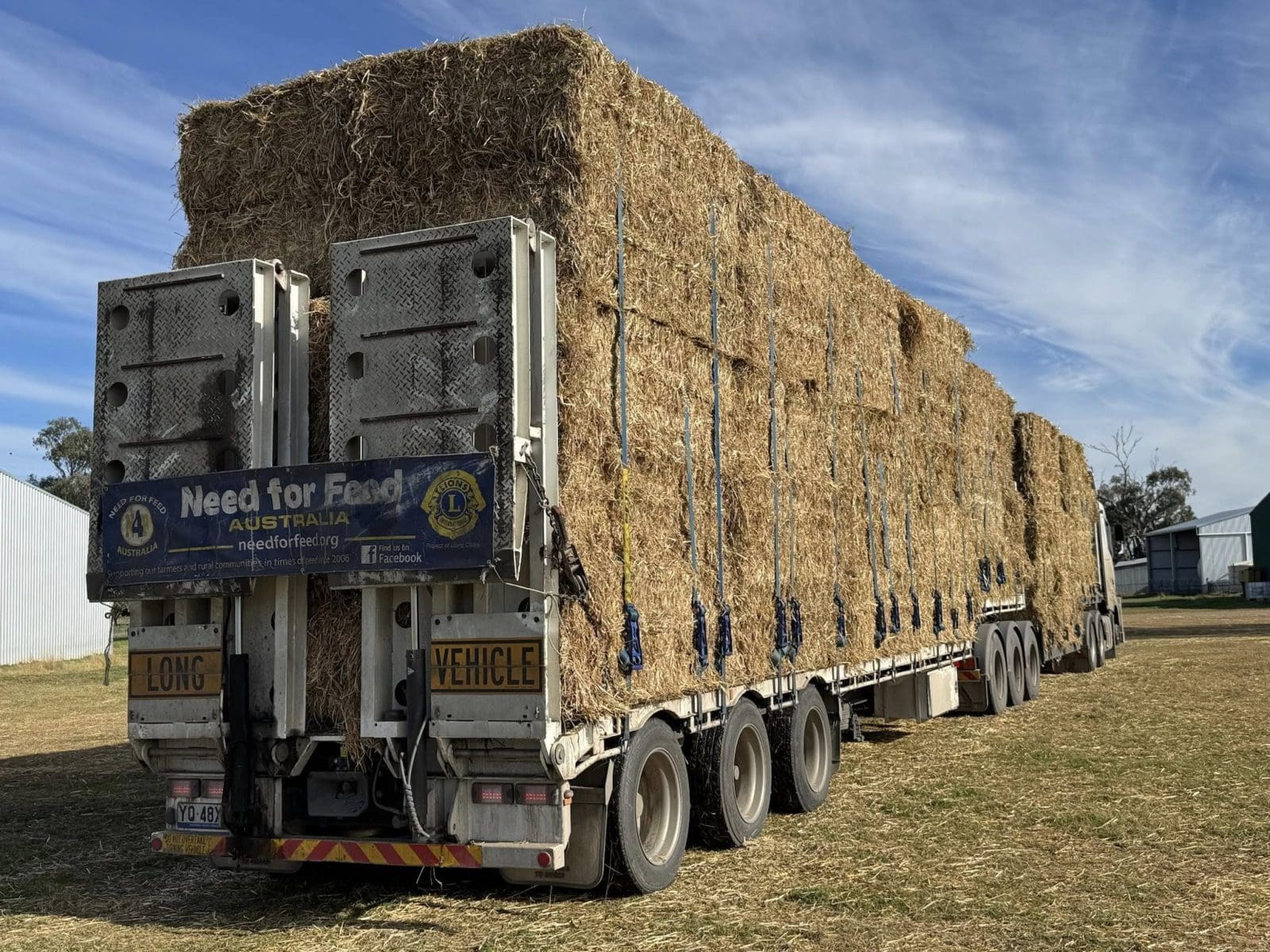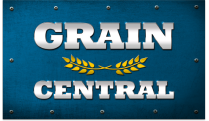
Charities have been able to access SA Government fodder freight subsidies, and are playing a crucial role in supporting SA livestock producers, including those accessing NSW hay donated and delivered to Jamestown on the June long weekend. Photo: Rapid Relief Team
RECENT rain in the drought-affected regions of south-eastern Australia has seen up-country barley prices drop a few dollars, but the fodder market is showing no sign of easing.
Cereal hay landed in South Australia and western Victoria continues to trade in volume at $500-$550 per tonne, well over double its pre-drought value.
With SA and Vic drained of available hay, loads from New South Wales and Western Australia are filling the feed gap ahead of sheep, cattle, and dairy herds moving back on to pasture in spring.
However, not all regions of SA or Vic have had enough rain to fire up pasture growth in time for spring grazing, and some crops planted for hay may therefore be sacrificed to provide feed.
Hay prices hold
Platinum Ag senior agronomist Matt Howell said 25-40mm of rain for SA’s South East in early June followed by 10mm has given “a green tinge” to the landscape as crops germinate and pastures regenerate.
“You wouldn’t call it feed yet, but it should be by late July,” Mr Howell said.
SA’s fodder shortage remains chronic, as evidenced by hay rolling in from WA, NSW, and even western Queensland, although some locals are releasing small amounts as cautious optimism about the season builds.
“The hay market hasn’t dropped.
“Major feedlots and dairies are buying hand over fist from a long way away.
“Lambing is underway and calving is underway, and people are lambing in confinement pens, which is not ideal.”
Mr Howell said barley and small amounts of wheat were being bought out of the bulk-handling system to feed livestock, but protein sources such as lupins were in very tight supply.
Emerging crops bring hope
Some crops have run into residue issues caused by herbicide which did not receive activating rain during last year’s growing season.
“Crops are emerging and looking okay, but there are a lot of residue issues.”
Platinum Ag Mid North agronomist Phil Holmes said some districts west of Clare need more than the 10-15mm this month has delivered so far to get crops and pastures going.
However, much of the region has had good rain, and another front tipped to deliver at least 10mm next week will further improve prospects.
“There’s been mostly enough rain for now; from Jamestown to Gladstone and Laura, and down to Clare and east has had…30mm,” Mr Holmes said.
“Crops are just starting to poke through, but the pasture hills all look very bare.”
While cereals have generally fully emerged, some canola paddocks are only 20pc out of the ground, and hand-feeding looks set to continue for at least six weeks.
“They’ll be needing to feed until August or maybe as late as September.
“Hay is getting extraordinarily scarce, and people are now getting it from the Northern Territory and WA.”
“A lot of people in the Mid North have lambs on the ground already; they’re getting tagged and vaccinated now.
“Normally they’d get put into the hills, and this year, they’ve got nothing in the hills to go to.”
This shortage of pasture on hill country means some paddocks sown for hay might be grazed out instead.
In regions including the Murray-Mallee, some producers have sown an extra paddock or two of barley to feed sheep in spring if required.
Dairy feels the pinch
SA Dairyfarmers’ Association chief executive officer Andrew Curtis said the need for high-quality hay has become acute for the state’s 180 dairy farms.
As of this month, the shortage has been alleviated somewhat by Primary Industries and Regions SA allowing in hay under permit from parts of WA not infested with green snails.
“We are bringing in road trains from WA,” Mr Curtis said.
Dairies, and graziers wanting high-spec hay, have been paying more than $600/t landed.
“Price went out the window a little while ago,” Mr Curtis said of the hay market.
“South Australia is empty, particularly of quality hay, which we need with dairy; they don’t produce high volumes of milk on survival rations.”
Vic has around 3000 dairy farms, one third of them in the state’s west, and they have been equally hard hit by drought, and buying up available hay within Vic’s borders.
“It’s been a shocker.”
SA dairies are predominantly on the Fleurieu Peninsula south of Adelaide, and in the South East, where spring is often slow to arrive.
“They won’t grow much pasture for another two or three months.”

SA Premier Peter Malinauskas meets with drought-affected producers at the Glencoe Woolshed near Mt Gambier last week. Photo: Nick McBride MP
SA dairies generally calve over the winter months, and corn silage, barley, cereal or lucerne hay, and supplementary protein sources like lupins are going into the feeders or bails.
While grain is not cheap, it is available at up-country sites, and its price has increased only modestly by comparison with the price hikes seen in fodder, driven by buoyant demand for a shrinking supply.
Because of their high nutritional requirement, dairy farmers have less options available to them than those feeding beef cattle and sheep.
“Our shortage now is around fibre, and we can’t use corn stubble or straw.”
Dairy cows are normally milked for around 300 days per year, during which time they require 15-20kg of fibre per day, or around 5.2t per annum.

A load of donated hay sets off from Somerton in northern NSW bound for Cobram in Vic. Photo: Need for Feed
Livestock SA still lobbying
The SA Government has earmarked $73 million in drought funding for farmers, businesses and communities affected by drought.
This does not include fodder and freight subsidies for producers, but it has been significant in providing freight subsidies to charities which continue to bring hay into regions from Eyre Peninsula in the west to the South East and Murray-Mallee on the Vic border.
“We’re still pushing really hard for freight subsidies,” Livestock SA communications and membership manager Hannah Trevilyan said.
The organisation is also pushing for no or low-interest loans as producers rack up hefty feed bills as they wait for pastures to regenerate and fodder supplies to be replenished in spring.
In the meantime, Rapid Relief Team and Need for Feed have more charity drops planned.
RRT is working with Save Our Sheep and the Lions Club to help distribute about 130t of donated livestock pellets to EP farmers.
It follows RRT’s Farmers Community Connect convoy two weeks ago, with volunteers trucking in 1562 donated hay bales from NSW to give to more than 200 farmers in Jamestown, SA.
RRT operations manager Mick Dunn said the charity has teamed up with Save Our Sheep founder Suzie Kenny, who has been advocating for EP farmers.
“Suzie has been tireless in her efforts to get more help for the Eyre Peninsula, and she has secured 88 tonnes of drought pellets thanks to a donation from the Lions Club,” Mr Dunn said.
“Another 46 tonnes of pellets have been given to RRT to distribute in the Eyre Peninsula, which were also purchased with Lions Club support, so this is truly a collaborative effort.
“Alongside the Lions Club, RRT will host a Farmers Community Connect event at Streaky Bay Racecourse on Friday, where 85 farmers can share a meal and take home free feed for their livestock.”
Ms Kenny said the morale of EP farmers has dropped after the region received less rain than was predicted in recent weeks.
“Farmers in the Eyre Peninsula are desperately waiting for something that will ease their burden, and it gets harder for them not to lose hope – so this donated feed will at least take a bit of the pressure off.
Grain Central: Get our free news straight to your inbox – Click here

HAVE YOUR SAY